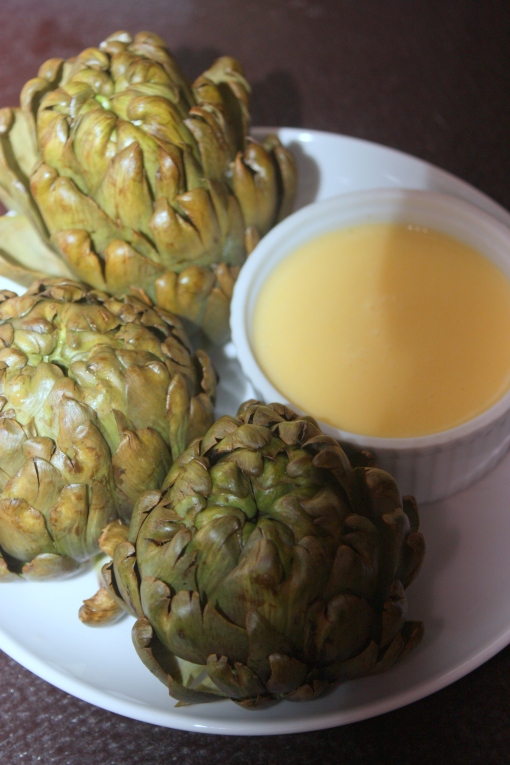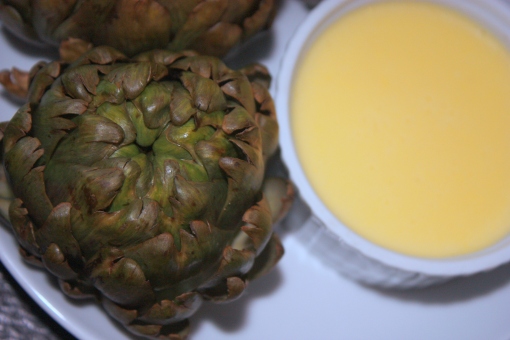I splurged at the market the other day. I saw 3 beautiful artichokes at the store on Wulumuqi Lu, and greedily snatched them right up, without any consideration for local food or price. It was bad, I admit it, and I’m not sorry I did it. If the Chinese even had a word for artichoke (朝鲜蓟, in case you were wondering, but no one knows what they are or how to eat them), I’d be more contrite, but for now, I’m celebrating my exciting market find.
And what better way to celebrate the natural flavors of the artichoke, than by steaming it and serving it with a classic hollandaise sauce?
Though it proved to be another girly dinner for Walker, I did give him two of the three artichokes. Given my love for artichokes, I thought that was very big of me. He had never eaten artichokes like this before, and at first, he claimed it was too labor intensive. Peeling back each leaf and using your teeth to peel back the succulent white meat inside, then tossing aside the tough green shell does seem like a lot of work if you’re looking at dinner as a quick fix.
But there is something to be said to returning to eating slowly, and savoring each small bite. Especially when you can cover each small bite with thick, salty, lemony butter so rich that it makes you wonder if you’ll be able to fit into your jeans the next morning. Mainlining a stick of butter in five minutes flat hardly seems like the best way to savor any treat, and I think by the time Walker reached the heart of the artichoke, he’d been converted. It’s not work. It’s indulgence.
This might just be better than ice cream. I’d eat it with a spoon if I thought I could get away with it. Instead I’ll just have to restrain myself ever so slightly, and use the artichoke leaves as makeshift spoons. Hardly a concession, huh? Oh well. I still think it’s the best possible way to enjoy the buttery soft artichoke.
Julia Child’s Hollandaise Sauce
makes 1 1/2 cups
Ingredients
3 egg yolks
1 tablespoon water
1 tablespoon fresh lemon juice, (or more, depending on your taste)
6-8 ounces very soft unsalted butter
1 dash cayenne pepper
salt, to taste
fresh ground white pepper, to taste
Preparation
1. Whisk the yolks, water, and lemon juice in the saucepan for a few moments, until thick and pale (this prepares them for what is to come).
2. Set the pan over moderately low heat and continue to whisk at reasonable speed, reaching all over the bottom and insides of the pan, where the eggs tend to overcook.
3. To moderate the heat, frequently move the pan off the burner for a few seconds, and then back on. (If, by chance, the eggs seem to be cooking too fast, set the pan in the bowl of cold water to cool the bottom, then continue).
4. As they cook, the eggs will become frothy and increase in volume, and then thicken. When you can see the pan bottom through the streaks of the whisk and the eggs are thick and smooth, remove from the heat.
5. By spoonfuls, add the soft butter, whisking constantly to incorporate each addition. As the emulsion forms, you may add the butter in slightly larger amounts, always whisking until fully absorbed. Continue incorporating butter until the sauce has thickened to the consistency you want.
6. Season lightly with salt, pepper, and a dash of cayenne pepper, whisking in well. Taste and adjust the seasoning, adding droplets of lemon juice if needed. Serve lukewarm.



December 29, 2011 at 1:43 pm
Unblock Games at School|Unblock MySpace at School|Unblock Internet Sites|Unblock Blocked Sites|Unknown Unblock Sites|Unblock MySpace at School codes|Access Blocked Sites|Unblock MySpace without Using Proxy…
[…]Julia Child’s Hollandaise Sauce « Experiments from a Tiny Kitchen in Shanghai[…]…
March 18, 2012 at 3:22 am
BMX…
[…]Julia Child’s Hollandaise Sauce « Experiments from a Tiny Kitchen in Shanghai[…]…